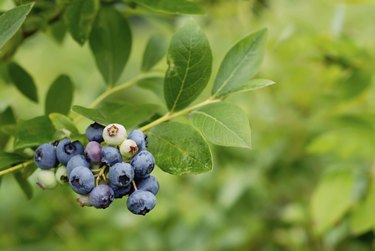
The yellownecked caterpillar (Datana ministra) is the larval stage of a moth that affects many types of plants, including blueberry (Vaccinium L.). Though outbreaks are rarely troublesome on the many varieties of blueberry plants, which grow in a range of U.S. Department of Agriculture plant hardiness zones from 4 through 8, the caterpillar can be a nuisance. Large outbreaks can leave behind mere skeletons of once-healthy bright, green leaves.
Description
Video of the Day
When young, the yellownecked caterpillar is red with yellow markings and yellow and white stripes along its body. A mature larva, which is about 2 inches long, has a black body with a yellow-to-orange neck and eight yellow or white lines running the length of its body. It is also lightly covered with long, pale hairs. The yellownecked caterpillar moth that emerges is reddish-brown and has four thin horizontal lines across its scalloped wings.
Video of the Day
Life Cycle
Each year after overwintering as pupae, yellownecked caterpillar moths appear during the summer months of June and July. Females lay clusters of eggs numbering a hundred or more under leaves. When the eggs hatch in late summer, the young larvae feed together in large groups as a defense against predators. During the months of August through October, they return as mature pupae to the soil where the cycle begins all over again. Some areas may have only one generation a year, while others may have several.
Damage
Small or young blueberry bushes are the most vulnerable to damage by yellownecked caterpillars. One group of 30 to 100 caterpillars can eat the leaves off an entire plant, while a large blueberry bush may only have a few areas defoliated. Damage consists of nibbles by young larvae on foliage and completely skeletonizing leaves by older larvae, which leave only the petiole intact. Over time, consistent defoliation will affect the health of a blueberry bush, so it's best to control damage before it results in serious stress.
Treatment
Mother Nature is the first line of defense against caterpillars. Natural predators such as hungry robins, tachinid flies, adverse weather conditions, disease and parasites keep populations down. Beyond that, the most effective method of control is early detection. Simply prune off leaves with egg clusters or young larvae. Keeping your blueberry bush healthy so it withstands any loss of foliage also helps. For numerous larvae, a ready-to-use mixture of the bacterial pesticide Bacillus thuringiensis k. can be sprayed on the upper and lower sides of dry leaves when caterpillars are feeding. It should be applied once after all caterpillars have hatched and again two weeks later, before they are 1/2-inch long. Always follow a particular product's instructions for use. More toxic pesticides are not only useless against mature caterpillars, they also harm the natural predators that feed on them, according to University of Florida IFAS Extension.
- NC State University Cooperative Extension: Small Fruit: Yellownecked Caterpillars
- University of Illinois Extension: Hort Answers: Insect Damage: Yellownecked Caterpillars
- Penn State College of Agricultural Sciences: Entomology: Yellownecked Caterpillar
- University of Florida IFAS Extension: An Early Fall?
- Cornell University Cooperative Extension of Suffolk County: Horticultural Diagnostic Laboratory: Growing Blueberries in Home Gardens
- Purdue Extension Entomology: Commonly Asked Questions About Btk (Bacillus Thuringiensis Var. Kurstaki)
- The Ohio State University Ornamental Bug Fact Sheets: Yellownecked Caterpillar